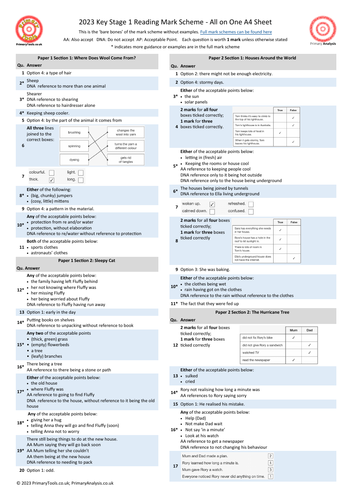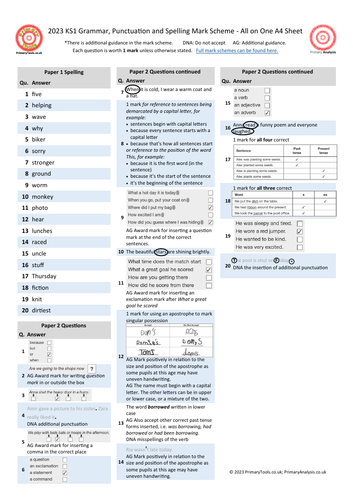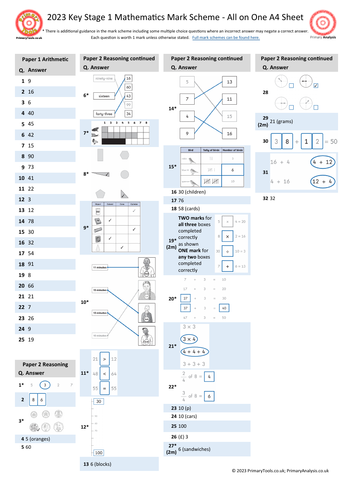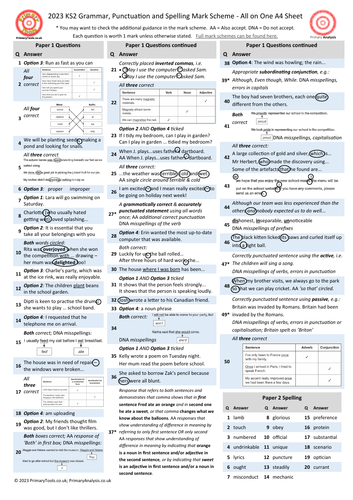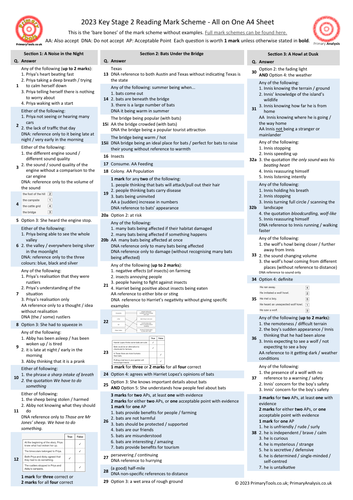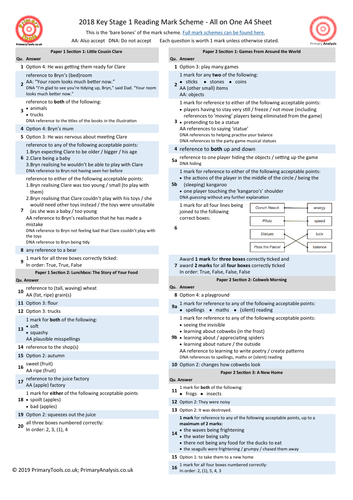
284Uploads
2076k+Views
2041k+Downloads
Whole school
Bundle

Rapid Series Bundle
Rapid Reading for UKS2, LKS2 and KS1
Rapid Grammar for UKS2 and LKS2
Rapid Arithmetic for UKS2 and LKS2

2022 Phonics Check Question Level Analysis
Summary of Features:
Pupil Summary shows total marks for each paper, number of questions unanswered, number of incorrect answers, total overall score (and percent), total score in each focus area. Option to adjust the colour thresholds to make it easier to spot patterns and gaps.
Pupil Reports show a summary of performance in each focus area for an individual pupil. Useful for feeding back to pupils, parents and informing intervention teachers.
Cohort Summary shows an overview of the cohort against each focus area. This page gives a summary of attainment including number and percent meeting the expected standard.
Other Charts Charts which show performance for each question, organised by most correct to incorrect and by word type.
Requires Excel with macros enabled.
Bundle

2022 KS1 and KS2 Test and Question Level Analysis Pack
2022 KS1 and KS2 Test and Question Level Analysis Pack
Includes all 2022 Analysis Tools for KS1 and KS2:
2022 KS1 SATs Grammar, Punctuation and Spelling Test and Question Level Analysis
2022 KS1 SATs Mathematics Test and Question Level Analysis
2022 KS1 SATs Reading Test and Question Level Analysis
2022 KS2 Grammar, Punctuation & Spelling Test and Question Level Analysis
2022 KS2 Mathematics Test and Question Level Analysis
2022 KS2 Reading Test and Question Level Analysis
2022 Phonics Check Question Level Analysis
Requires Excel with macros enabled.
Summary of Features (please note some features may not be available depending on the test type):
Questions Versus National compares the performance of your cohort against the performance of pupils nationally in each question. A powerful chart which instantly shows you which questions you are strong or weak on. As it uses national data, it considers the difficulty of each question, compares it the performance of your cohort and orders the results from strongest to weakest. 2016 to 2022 KS2 versions only, Q vs National will be added to the 2023 KS2 version at a later date.
Pupil Summary shows total marks for each paper, number of questions unanswered (possibly indicating need to increase pace), number of incorrect answers, total overall score (and percent), total score in each strand. Option to adjust the colour thresholds to make it easier to spot patterns and gaps.
Pupil Reports show a summary of performance in each strand for an individual pupils. Available in 2017 versions and later excluding reading. 2018 versions and later contain detailed feedback on each question. Useful for feeding back to pupils, parents and informing intervention teachers.
Contextual Analysis (2019 versions onwards) shows a breakdown by key groups (gender, SEND status, disadvantaged, EAL) plus up to four custom groups. Compares school data (grades and scaled scores) to national data in a detailed but user-friendly report.
Cohort Summary shows an overview of the cohort against each strand. This is also compared to national data where it is available. This page gives a summary of attainment including number and percent at expected and higher standard.
Strand Summary shows a the weighting of each strand and the performance within it. For example, in a grammar test a cohort may perform poorly in identifying sentence types and equally poorly in identifying punctuation. However as there is more weighting given to punctuation, it would be advisable to focus on this area.
Other Charts Charts which show performance for each question, organised by most correct to incorrect, by strand and also by year group question (for mathematics). The most powerful chart orders questions from most correct to incorrect enabling you to see precisely where there are strengths and weaknesses.
2022 KS1 and KS2 Test and Question Level Analysis Pack

2019 KS2 Mathematics Question Level Analysis
Summary of Features (please note some features may not be available depending on the test type):
Pupil Summary shows total marks for each paper, number of questions unanswered (possibly indicating need to increase pace), number of incorrect answers, total overall score (and percent), total score in each strand. Option to adjust the colour thresholds to make it easier to spot patterns and gaps.
Pupil Reports show a summary of performance in each strand for an individual pupils. Available in 2017 versions and later excluding reading. 2018 versions and later contain detailed feedback on each question. Useful for feeding back to pupils, parents and informing intervention teachers.
Cohort Summary shows an overview of the cohort against each strand. This is also compared to national data where it is available. This page gives a summary of attainment including number and percent at expected and higher standard.
Strand Summary shows a the weighting of each strand and the performance within it. For example, in a grammar test a cohort may perform poorly in identifying sentence types and equally poorly in identifying punctuation. However as there is more weighting given to punctuation, it would be advisable to focus on this area.
Other Charts Charts which show performance for each question, organised by most correct to incorrect, by strand and also by year group question (for mathematics). The most powerful chart orders questions from most correct to incorrect enabling you to see precisely where there are strengths and weaknesses.

2023 KS1 SATs Grammar, Punctuation and Spelling Test and Question Level Analysis
2023 KS1 Grammar, Punctuation and Spelling Test and Question Level Analysis
Requires Excel with macros enabled.
Summary of Features (please note some features may not be available depending on the test type):
Pupil Summary shows total marks for each paper, number of questions unanswered (possibly indicating need to increase pace), number of incorrect answers, total overall score (and percent), total score in each strand. Option to adjust the colour thresholds to make it easier to spot patterns and gaps.
Pupil Reports show a summary of performance in each strand for an individual pupils. Useful for feeding back to pupils, parents and informing intervention teachers.
Contextual Analysis shows a breakdown by key groups (gender, SEND status, disadvantaged, EAL) plus up to four custom groups. Compares school data (grades and scaled scores) to national data in a detailed but user-friendly report.
Cohort Summary shows an overview of the cohort against each strand. This is also compared to national data where it is available. This page gives a summary of attainment including number and percent at expected and higher standard.
Strand Summary shows a the weighting of each strand and the performance within it. For example, in a grammar test a cohort may perform poorly in identifying sentence types and equally poorly in identifying punctuation. However as there is more weighting given to punctuation, it would be advisable to focus on this area.
Other Charts Charts which show performance for each question, organised by most correct to incorrect, by strand and also by year group question (for mathematics). The most powerful chart orders questions from most correct to incorrect enabling you to see precisely where there are strengths and weaknesses.

2022 KS2 Grammar, Punctuation & Spelling Test and Question Level Analysis
2022 KS2 Grammar, Punctuation & Spelling Test and Question Level Analysis
Requires Excel with macros enabled.
Summary of Features:
Questions Versus National compares the performance of your cohort against the performance of pupils nationally in each question. A powerful chart which instantly shows you which questions you are strong or weak on. As it uses national data, it considers the difficulty of each question, compares it the performance of your cohort and orders the results from strongest to weakest. 2016 to 2022 KS2 versions only, Q vs National will be added to the 2023 KS2 version at a later date.
Pupil Summary shows total marks for each paper, number of questions unanswered (possibly indicating need to increase pace), number of incorrect answers, total overall score (and percent), total score in each strand. Option to adjust the colour thresholds to make it easier to spot patterns and gaps.
Pupil Reports show a summary of performance in each strand for an individual pupils. Available in 2017 versions and later excluding reading. 2018 versions and later contain detailed feedback on each question. Useful for feeding back to pupils, parents and informing intervention teachers.
Contextual Analysis (2019 versions onwards) shows a breakdown by key groups (gender, SEND status, disadvantaged, EAL) plus up to four custom groups. Compares school data (grades and scaled scores) to national data in a detailed but user-friendly report.
Cohort Summary shows an overview of the cohort against each strand. This is also compared to national data where it is available. This page gives a summary of attainment including number and percent at expected and higher standard.
Strand Summary shows the weighting of each strand and the performance within it. For example, in a grammar test a cohort may perform poorly in identifying sentence types and equally poorly in identifying punctuation. However as there is more weighting given to punctuation, it would be advisable to focus on this area.
Other Charts Charts which show performance for each question, organised by most correct to incorrect, by strand and also by year group question (for mathematics). The most powerful chart orders questions from most correct to incorrect enabling you to see precisely where there are strengths and weaknesses.
2022 KS2 Grammar, Punctuation & Spelling Test and Question Level Analysis

2023 KS1 SATs Mathematics Test and Question Level Analysis
2023 KS1 Mathematics Test and Question Level Analysis
Requires Excel with macros enabled.
Summary of Features (please note some features may not be available depending on the test type):
Pupil Summary shows total marks for each paper, number of questions unanswered (possibly indicating need to increase pace), number of incorrect answers, total overall score (and percent), total score in each strand. Option to adjust the colour thresholds to make it easier to spot patterns and gaps.
Pupil Reports show a summary of performance in each strand and per question for an individual pupils. Useful for feeding back to pupils, parents and informing intervention teachers.
Contextual Analysis shows a breakdown by key groups (gender, SEND status, disadvantaged, EAL) plus up to four custom groups. Compares school data (grades and scaled scores) to national data in a detailed but user-friendly report.
Cohort Summary shows an overview of the cohort against each strand. This is also compared to national data where it is available. This page gives a summary of attainment including number and percent at expected and higher standard.
Strand Summary shows a the weighting of each strand and the performance within it. For example, in a grammar test a cohort may perform poorly in identifying sentence types and equally poorly in identifying punctuation. However as there is more weighting given to punctuation, it would be advisable to focus on this area.
Other Charts Charts which show performance for each question, organised by most correct to incorrect, by strand and also by year group question (for mathematics). The most powerful chart orders questions from most correct to incorrect enabling you to see precisely where there are strengths and weaknesses.

2023 KS1 SATs Grammar, Punctuation and Spelling Test Mark Scheme on a Page
2023 KS1 SATs Grammar, Punctuation and Spelling Test Mark Scheme on a Page

2023 KS1 SATs Mathematics Test Mark Scheme on a Page
2023 KS1 SATs Mathematics Test Mark Scheme on a Page

2023 KS2 SATs Grammar, Punctuation and Spelling Test Mark Scheme on a Page
2023 KS2 SATs Grammar, Punctuation and Spelling Test Mark Scheme on a Page

KS2 National Curriculum Tests Comparison - 2016 onwards (updated with 2023 tests)
An analysis and comparison of the KS2 National Curriculum Tests (SATs) from 2016 onwards.

2022 KS1 SATs Reading Test and Question Level Analysis
2022 KS1 Reading Test and Question Level Analysis
Requires Excel with macros enabled.
Summary of Features (please note some features may not be available depending on the test type):
Pupil Summary shows total marks for each paper, number of questions unanswered (possibly indicating need to increase pace), number of incorrect answers, total overall score (and percent), total score in each strand. Option to adjust the colour thresholds to make it easier to spot patterns and gaps.
Pupil Reports show a summary of performance in each strand and per question for an individual pupils. Useful for feeding back to pupils, parents and informing intervention teachers.
Contextual Analysis shows a breakdown by key groups (gender, SEND status, disadvantaged, EAL) plus up to four custom groups. Compares school data (grades and scaled scores) to national data in a detailed but user-friendly report.
Cohort Summary shows an overview of the cohort against each strand. This is also compared to national data where it is available. This page gives a summary of attainment including number and percent at expected and higher standard.
Strand Summary shows a the weighting of each strand and the performance within it. For example, in a grammar test a cohort may perform poorly in identifying sentence types and equally poorly in identifying punctuation. However as there is more weighting given to punctuation, it would be advisable to focus on this area.
Other Charts Charts which show performance for each question, organised by most correct to incorrect, by strand and also by year group question (for mathematics). The most powerful chart orders questions from most correct to incorrect enabling you to see precisely where there are strengths and weaknesses.

2023 KS1 SATs Reading Test & Comprehensive Question Analysis Tool
Boost Success: 2023 KS1 Reading Test & Question Analysis (Excel with Macros)
Summary of Features (features may vary based on test type):
Pupil Summary: View total marks, unanswered questions, incorrect answers, overall score, and scores in each strand. Customize color thresholds for pattern spotting.
Pupil Reports: Provide feedback on performance in strands and per question.
Contextual Analysis: Breakdown by key groups (gender, SEND, disadvantaged, EAL) and compare to national data.
Cohort Summary: Overview of cohort’s performance and compare to national standards.
Strand Summary: Weighting of strands and performance analysis.
Other Charts: Charts showing question performance and strengths/weaknesses.
Experience the power of this 2023 KS1 SATs Reading Test & Question Analysis Tool for educational insights, interventions, and student achievement.

KS1 and KS2 2019 Grammar Punctuation and Spelling Mark Scheme on a Page
KS1 and KS2 2019 Grammar Punctuation and Spelling Mark Scheme on a Page

2016 EYFS Data Analysis Tool
Analyse your EYFS assessments with ease.
Automatically calculates Good Level of Development using the Early Learning Goals and breaks down the data for the following key groups:
Whole Cohort (up to 125 pupils)
By Class (up to four classes)
Disadvantaged/Non Disadvantaged
Gender
Recommended: Excel 2010 onwards with macros enabled

2017 KS1 National Curriculum Test for Reading Electronic Analysis
Works best in Excel 2010 or later with macros enabled
New features for the 2017 version include Age Related Expectations reporting and improved presentation of graphs








